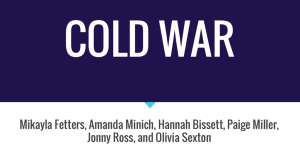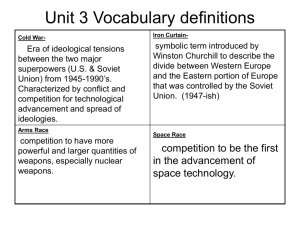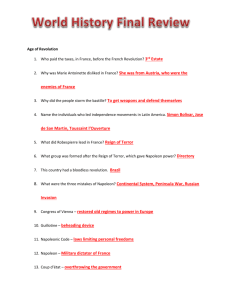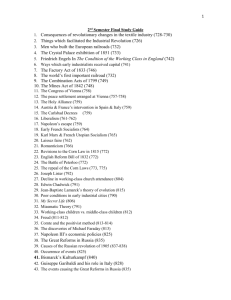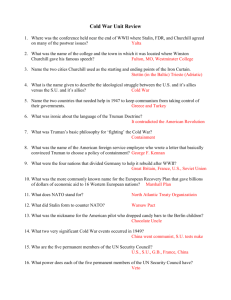APHG Timeline
advertisement
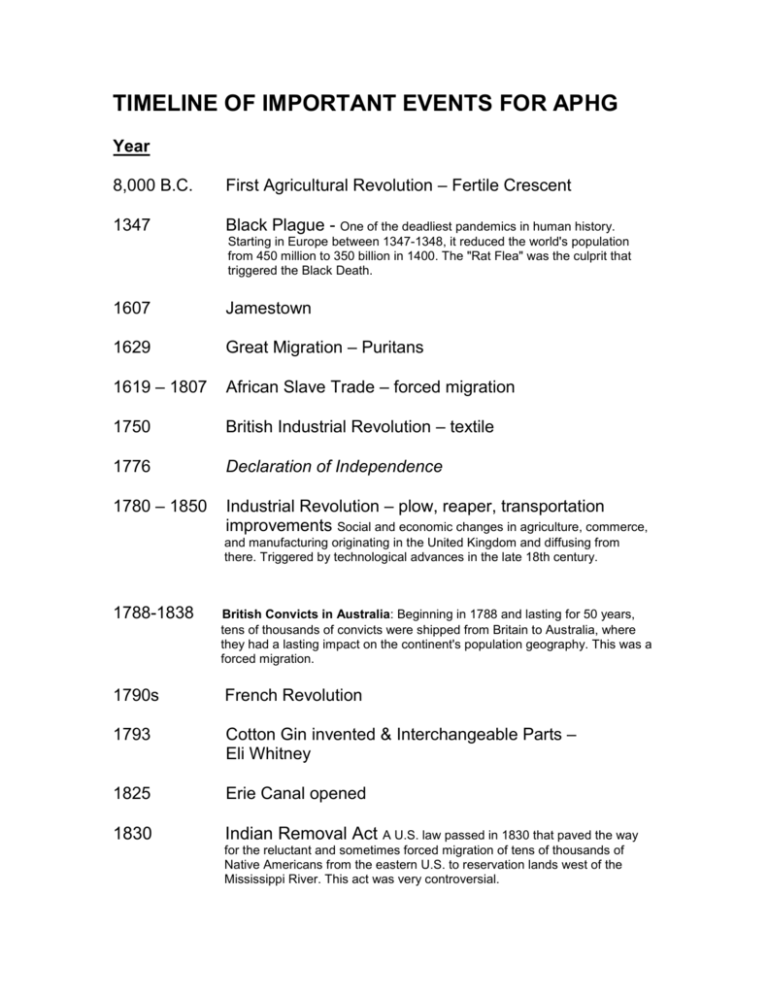
TIMELINE OF IMPORTANT EVENTS FOR APHG Year 8,000 B.C. First Agricultural Revolution – Fertile Crescent 1347 Black Plague - One of the deadliest pandemics in human history. Starting in Europe between 1347-1348, it reduced the world's population from 450 million to 350 billion in 1400. The "Rat Flea" was the culprit that triggered the Black Death. 1607 Jamestown 1629 Great Migration – Puritans 1619 – 1807 African Slave Trade – forced migration 1750 British Industrial Revolution – textile 1776 Declaration of Independence 1780 – 1850 Industrial Revolution – plow, reaper, transportation improvements Social and economic changes in agriculture, commerce, and manufacturing originating in the United Kingdom and diffusing from there. Triggered by technological advances in the late 18th century. 1788-1838 British Convicts in Australia: Beginning in 1788 and lasting for 50 years, tens of thousands of convicts were shipped from Britain to Australia, where they had a lasting impact on the continent's population geography. This was a forced migration. 1790s French Revolution 1793 Cotton Gin invented & Interchangeable Parts – Eli Whitney 1825 Erie Canal opened 1830 Indian Removal Act A U.S. law passed in 1830 that paved the way for the reluctant and sometimes forced migration of tens of thousands of Native Americans from the eastern U.S. to reservation lands west of the Mississippi River. This act was very controversial. 1836 Trail of Tears – forced migration 1840s Irish Potato Famine – push factor Irish Potato Famine: Time of great starvation across Ireland that occurred between 1845 and 1852. Also, this was a time of much emigration and disease. Overall about one million people died, and Ireland lost about one fourth of its population. The cause of all of this was a disease that grew in the potato crop, and because of that, the potato crop failed, and plunged Ireland into starvation. 1840 – 1880 First Wave of U.S. Immigration (“Old Immigration”) – Northern & Western Europeans 1870s U.S. Industrial Revolution – steel, railroads 1880 – 1920 Second Wave of U.S. Immigration (“New Immigration”) – Southern & Eastern Europeans 1870 – 1920 Rural – Urban Migration 1882 Chinese Exclusion Act early 1900s African American Migration to Northern Cities "The Great Migration": The movement of approximately 2 million African Americans from southern United States to the north and west regions. The movement was caused because the African Americans wanted to get away from the racism, and wanted to find work in industrial cities. The approximate dates for this movement are from 1910-1940. 1910s Mexican Revolution – push factor 1914 – 1918 World War I 1915 Russian Revolution The Union of Soviet Socialist Republics was a socialist state combining the Russian, Ukrainian, Belarusian, and Transcaucasian Soviet republics. The Soviet Union existed between 1922 and 1991. Vladimir Lenin was the first Soviet ruler. After his death he was replaced by Joseph Stalin, who led the country through an industrialization. After an attack by the Germans during WWII, the Soviet Union became a superpower and was able to extend its reach into Eastern Europe. The Soviet Union was gradually weakened, and fully fell apart when the republics of the Union started declaring independence. 1924 National Origins Act – limits immigration to 2% of the 1890 U.S. Census 1924 Stalin Takes over USSR Josef Stalin was born December 28, 1878 and died March 5, 1953. In 1924, he rose to become the leader of the Soviet Union, which he ruled as a dictator. He was the longtime ruler who more than any other individual molded the features that characterized the Soviet regime and shaped the direction of Europe following the end of World War II in 1945. 1929 – 1939 Great Depression 1939 – 1945 World War II 1945 – 1970 Green Revolution – miracle seeds, irrigation, fertilizers 1945 – 1989 Cold War – tensions between two superpowers USSR and U.S. The Cold War: The Cold War started soon after World Nazi Germany: Nazi Germany was the common English name for Germany under the control of Adolf Hitler and the National Socialist German Workers Party, which established a dictatorship that existed from 1933 to 1945. The state was known as the"Greater German Reich." This state was a major European power from the 1930's-1940's and its historical significance lies mainly in its key role in the onset of World War II and its commission of large-scale crimes against humanity, such as the persecution and the mass-murder of millions of Jews, minorities, and dissidents in the genocide known as the Holocaust. War II (from about 1947–1991). It was a longstanding conflict between the United States and the Soviet Union. Neither the United States nor the Soviet Union wanted to openly fight each other and they were afraid of each other’s power. The Americans and Russians even managed to take their war to space, launching spacecraft in retaliation to the other's launching. In fact, the main reason why the war lasted so long was that both the countries were fighting indirectly. Eventually the coldness between each nations started taking over other countries too and it became a war of the communist world versus the non-communist and democratic nations. The tensions only mounted and both the United States and the Soviet Union had nuclear weapons (so they had to be careful). Presidents and Prime Ministers on either side came and went. The Cold War faded out when the Berlin Wall came down and the Soviet Union fell apart. 1947 India and Pakistan (East and West) created when Britain ended colonial rule Partition of India into India, Pakistan and Bangladesh: What is now India, Pakistan, and Bangladesh used to be all one country, controlled by Britain, called British India. In 1947, it was freed of British control. It was left divided according to religion, Islamic Pakistan and Hindu India. Muslims wanted to decrease the number of nonbelievers to 0, so they declared a war. When the war was finished, India repatriated millions of Hindu refugees back into the area that is now Bangladesh and it became a state. 1948 Israel created – Palestinian refugees United Nations establishment of Israel: On May 14, 1948, the United Nations established Israel as an official state. This was done because many years after the Jewish diaspora, the Jewish people dreamed of reuniting together to the "holy land" in and around Jerusalem in the idea of Zionism. In order to establish a new state though, the U.N. had to move another group aside, and that group was the Palestinians. This was not a peaceful movement for the Palestinians 1948-present Arab-Israeli Conflict: As stated above, the Israelites moved back to areas around Jerusalem, and this created a problem between the Arabs and Israelis. They both were entitled to the land (Israelis lived there before the diaspora, and Arabs have lived there since.) The Zionist Jews believe that because their ancestors were from Jerusalem, that they should be able to control the territory. This conflict has been going on for decades, and has attracted worldwide attention, but the end is not yet in sight. 1949 North Atlantic Treaty Organization (NATO): The North Atlantic Treaty Organization is an intergovernmental military alliance based on the North Atlantic Treaty which was signed in April 1949. The NATO headquarters are in Brussels, Belgium, and the organization constitutes a system of collective defense whereby its member states agree to mutual defense in response to an attack by any external party. For its first few years, NATO was not much more than a political association. However, the Korean War startled the member states, and an integrated military structure was built up under the direction of two U.S. supreme commanders. The NATO goal was "to keep the Russians out, Americans in, and Germans down." After the fall of the Berlin Wall in 1989, the organization became drawn into the Balkans while building better links with former potential enemies to the east, which culminated with several former Warsaw Pact states joining the alliance in 1999 and 2004. On 1 April 2009, membership was enlarged to 28 with the entrance of Albania and Croatia. Since the 11 September attacks, NATO has attempted to refocus itself to new challenges and has deployed troops to Afghanistan as well as trainers to Iraq. 1950s Japan / East Asia Industrial Revolution – electronics, retail 1950s Urban – Suburban Migration 1950s End of African colonization – Neocolonialism begins 1953 Korean Demilitarized Zone (DMZ): The Korean Demilitarized Zone is a strip of land running across the Korean Peninsula that serves as a buffer zone between North and South Korea. The DMZ cuts the Korean Peninsula roughly in half, crossing the 38th parallel on an angle, with the west end of the DMZ lying south of the parallel and the east end lying north of it. It is 250 kilometers (160 miles) long, approximately 4 km (2.5 mi) wide and is the most heavily militarized border in the world. 1954-1978 Vietnam War: The Vietnam War was a conflict in Southeast Asia, primarily fought in South Vietnam between government forces aided by the United States and guerrilla forces aided by North Vietnam. The war began soon after the Geneva Conference provisionally divided (1954) Vietnam at 17° N into the Democratic Republic of Vietnam (North Vietnam) and the Republic of Vietnam (South Vietnam). It escalated from a Vietnamese civil war into a limited international conflict in which the United States was deeply involved, and did not end, despite peace agreements in 1973, until North Vietnam's successful offensive in 1975 resulted in South Vietnam's collapse and the unification of Vietnam by the North. 1961 Berlin Wall and "Iron Curtain": The Berlin Wall was a barrier constructed by East Germany beginning on 13 August 1961, that cut off West Berlin from surrounding East Germany and from East Berlin. The Wall served to prevent the massive emigration and defection that marked Germany and the communist Eastern Bloc during the post-World War II period. The concept of the "Iron Curtain" symbolized the ideological fighting and physical boundary dividing Europe into two separate areas from the end of World War II in 1945 until the end of the Cold War in 1989. 1965 Immigration Act of 1965 – 1972 Idi Amin: Uganda's dictator who in 1972 expelled 50,000 Asians and Ugandans of Asian descent from his country. This is an example of migration due to political circumstances. 1980 "Russification": A policy employed by the Soviet government during the communist period which encouraged people of Russian heritage to move out of the Moscow region and fill in the country. By 1980 as many as 30 million Russians had moved out toward the borders. That number has declined since the Soviet collapse, but the map will long carry the impact of Russia's eastward expansionism. 1980s Marianas Boat Lift – Cuban refugees Mariel Boat Lift: A mass emigration from Cuba in 1980 where numerous Cubans left Cuba from Mariel Harbor to try and reach asylum in America. The Cuban government gave the people the choice to leave, and many Cubans took advantage of this opportunity. The American government did not like this, and eventually the two governments signed a treaty to end the process, but it was estimated that 125,000 Cubans reached American soil during the time. 1970 – 1980 Asian Immigration "Boat People": A general term that refers to people searching for asylum, or illegal immigrants who emigrate from their home country in unsafe boats. Often there are numerous people on one boat that is meant to carry far less than what is on it. The term originated from the numerous Vietnam emigrants, and a current example would be the people coming over from Haiti in search of a better life. 1979 Soviet Invasion of Afghanistan – Afghan refugees Soviet Invasion of Afghanistan: The Soviet troops began invading Afghanistan in 1979 because they claimed that their intent was to support the Amin government currently governing Afghanistan. This party was disliked by many people in Afghanistan, and the Russian "invasion" elevated the issue. Later in 1979, Amin was assassinated and a Russian leader took his place. He needed military support because all of the Afghanistan soldiers left when their leader was killed. The people of Afghanistan (Mujahideen), fought a war against the Soviets, and by 1982, they controlled 3/4 of Afghanistan. Eventually, the Soviet Union pulled out because they realized the war was hurting their already weak economy, so the war ended with a Mujahideen victory. 1983 Sri Lanka Civil War: The civil war in Sri Lanka has affected every aspect of the nation's development. The origins of the Sri Lankan Civil War lie in the continuous political rancor between the majority Sinhalese and the minority Tamils. Since the war began in 1983, over 800,000 people, primarily Tamils, have become refugees, and over 62,000 Sri Lankans have lost their lives. Other countries in the past have tried and failed to create peace in Sri Lanka. But, on May 19, 2009, the Sri Lankan government formally declared an end to the 25-year civil war after the army took control of the entire island and killed the leaders of the Tamil Tigers. 1983-present Colombian Narcoterrorism: 90% of cocaine and almost 50% of heroin consumed in the United States is produced in Colombia. Money from the drug industry funds terrorists, drug cartels, and rebel groups such as the Revolutionary Armed Forces of Colombia. The U.S. is providing help for the Colombian military to combat the narcoterrorists and ensure safety for their citizens. 1990-1991 Persian Gulf War: The Persian Gulf War (August 2, 1990 - February 28, 1991) was a war waged by a U.N.-authorized coalition force from thirty-four nations led by the United States and United Kingdom, against Iraq. It was an international conflict triggered by Iraq's invasion of Kuwait in August 1990. The United States, fearing Iraq's broader strategic intentions and acting under UN auspices, eventually formed a broad coalition, which included a number of Arab countries, and began massing troops in northern Saudi Arabia. When Iraq ignored a UN Security Council deadline for it to withdraw from Kuwait, the coalition began a large-scale coalition offensive. A ground offensive by the coalition achieved victory. The war caused many deaths, as well as damage to the region's environment. 1991 Soviet Union collapses – created 15 newly independent states Break-up of Former Yugoslavia: Former Yugoslavia was thrown together by Great Britain after WWI. Tons of different ethnicities, languages, religions, and other cultural factors were present in Yugoslavia. A lot of the groups, mainly Serbs, Croats, and Bosnians, tried to ethnically cleanse each other. A treaty called the Dayton-Accord Partition broke up the Serbs and Croats' war, which drove millions of Bosnians from their homes. Soon the UN established separate states for each of the groups, diminishing Yugoslavia. 1994 Apartheid ended in South Africa 1994 Rwandan Genocide The Rwandan Genocide was the 1994 mass murder of an estimated 800,000 people over the course of approximately 100 days, according to a Human Rights Watch estimate. This was a result of a civil war between two ethnic groups, the Tutsis and the Hutus. 1994 North American Free Trade Agreement (NAFTA): On January 1, 1994, the North American Free Trade Agreement between the United States, Canada, and Mexico (NAFTA) entered into force. All remaining duties and quantitative restrictions were eliminated, as scheduled, on January 1, 2008. This agreement creates a trilateral trade bloc in North America. NAFTA created the world's largest free trade area, which now links 444 million people producing $17 trillion worth of goods and services. Trade between the United States and its NAFTA partners has soared since the agreement entered into force. 1992 – 1994 U.S. involvement in Somalia – individual clans made claims to portions of the country 1994-present Mexican Zapatistas: The Mexican Zapatistas are a liberation army that started in 1994 and is still going today. They declared a war against the Mexican government, even though it's not a violent war, just defensive against the military, paramilitary, and corporate invasions on their land. It is mainly made up of indigenous people with their base in Chiapas, Mexico. They do have some supporters that live in urban areas, too. 1990s Civil War in the Sudan – black Christian/animists in the South vs. Arab-Muslims in the North Darfur Genocide: A genocide against black Africans in favor of Arabs currently taking place in the region of Darfur, Sudan. Sudanese militia, in particular the Janjaweed group, are the ones responsible for at least twenty thousand civilian deaths from the conflict. They are being opposed by rebel groups such as JEM, the Justice and Equality Movement, and SLM/A, the Sudan Liberation Movement/Army. 1990’s E-commerce – Dot Com craze 1990 – present Latin American Immigration 1996 Taliban movement: An Islamic Fundamentalist movement which in 1996 emerged in Afghanistan and took control of most of the country, imposing strict Islamic rule and suppressing the factional conflicts that had prevailed since the Soviet withdrawal. Although several hundred thousand Pashtun refugees moved back to Afghanistan from Pakistan, the harsh Taliban rule created a counter-migration and led to further refugee movement into neighboring Iran, where their number reached 2.5 million. Eventually, Afghanistan became a base for anti-Western terrorist operations, which reached a climax in the attack on the U.S. on Sept. 11, 2001 2001 September 11th Terrorist Attacks:
